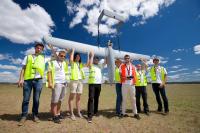WUT is a high flyer – KNA MelAvio
If only they could, they would busy themselves in their workshop until late. MelAvio – the Avionics Research Club – is doing its best to triumph in the UAV Challenge Medical Express 2016 international competition which is to be held in September in Australia.
This biennial competition attracts not only the best academic teams from all over the world but also companies whose business entails the production of unmanned aerial vehicles. The University of Queensland and the Australian Research and Development Institute are the organisers of the event.
The sky is the limit
The Avionics Research Club – MelAvio – started its dynamic activity three years ago, which coincided with the beginning of preparations for the previous edition of the UAV Challenge 2014. At the time MelAvio built a drone called the M6 Baracuda weighing 25kg. “The plane was supposed to search an area and analyse images to find Outback Joe - (a mannequin lying in the middle of a field), then drop an emergency package containing a bottle of water”, explains Jakub Polaczek, head of the Research Club.
On that occasion, the success of the team from the Warsaw University of Technology was huge. Out of all 180 competing teams the MelAvio team ranked 10th.
Having been built from scratch, the MelAvio plane stood out from the remaining aerial vehicles. In the workshop of their Research Club operating at the Warsaw University of Technology, Research Club members had constructed a full system: starting from the plane itself, through a system of vision to an autopilot.
An intelligent aerial vehicle
With the upcoming event in mind, MelAvio members have designed, produced and integrated the M7 Murena - a complete VTOL unmanned aerial vehicle system. The platform weighs 12kg and is a combination of a plane and a multirotor, which is why it is able to take off vertically and hover. Constructing such unmanned vehicles is a truly complicated process.
“We start from identifying the requirements that have to be met by aerial vehicles during the competition”, says Adam Korczak, Deputy Head of the Research Club and MelAvio’s main designer of the Murena. “We have to consider requirements as to the flight range and its speed as well as equipment to be put on board – cameras, a computer, an autopilot, etc.
A complete autopilot set with an on-board computer, gyro-stabilised inspection camera and other instruments indispensable for the drone to move are installed on the Murena’s board.
The drone built by MelAvio is not a toy. Its objective is lofty and noble – assistance to people in crisis situations. Such machines can be used for the purpose of search and rescue missions in otherwise inaccessible areas, during natural disasters and wars.
Rescuing by remote control
To be able to enter the competition, teams have to suggest an idea for the performance of the competition task, present construction documentation and demonstrate how the structure behaves airborne. The number of flight hours performed by their drone must also be documented.
During the competition, unmanned aerial vehicles will have to perform a search and rescue mission without an operator. The mission includes a take-off, travel to the search zone, finding Outback Joe, landing nearby, taking a blood sample, another take-off and the return to the base. The drone has to cover a distance of about 60km.
The unmanned aerial vehicle has to perform all the tasks unaided. The flight route and all tasks to be performed are programmed on the base station. When performing the tasks, the system suggests ways in which a problem could be solved and the person supervising the flight only approves certain solutions. The organisers of the competition emphasise the importance of mission safety. Teams have to prepare solutions in case of any complications: loss of communication or leaving the operation area.
A clear objective: the competition in Australia
MelAvio wants to use its experience gained during the previous UAV Challenge as a base on which to succeed in September. This year, when building the M7 Murena, the team from the Warsaw University of Technology will use ready-made systems and modify them to suit their own drone.
“The construction of the previous unmanned aerial vehicle allowed us to gain extensive knowledge of how all systems cooperate”, emphasises Jakub Polaczek. “It is a well-known fact that a construction made from scratch is not ideal. Using refined and well-known systems facilitates work, we have a better understanding of how they may behave”.
The final furlong
In April, the organiser of the competition accepted without reservations a report and video footage presenting the current preparation stage (Deliverable 2). For the time being our team is one of 10 teams from all over the world, which have been given a clean “GO” decision. The deadline for the last qualifying stage – documentation of flight hours – is in August. The Avionics Research Club is convinced that their drone will go through that stage without a problem. Their unmanned aerial vehicle was presented at the “Mazury Drone Show 2016” during a May event.
The main prize awarded in the UAV Challenge Medical Express 2016 amounts to AUD 50,000. Being able to exchange experiences and meet designers from all over the world is the added value from participating in the competition. MelAvio members emphasise that they are going to Australia to win.
Monika Bukowska
Office for Promotion and Information








